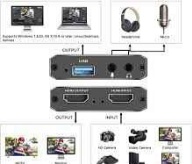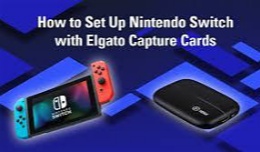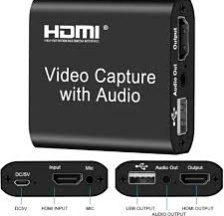As a professional gamer, I understand the importance of capturing high-quality gameplay footage when it comes to gaming content creation. This is where a Switch capture card comes into play. A Switch capture card is a device that allows gamers to capture and record their gameplay from their Nintendo Switch console. By connecting the capture card to the Switch and then to a computer, users can easily capture, stream, and share their gameplay in HD quality. This tool is essential for gamers looking to create engaging content for platforms like YouTube and Twitch. With a Switch capture card, users can showcase their gaming skills, share their gaming experiences, and connect with a community of fellow gamers in a seamless and professional manner.
The Indispensable Guide to Nintendo Switch Capture Cards
The Nintendo Switch has revolutionized gaming, offering both console and handheld experiences in one sleek package. But for streamers, content creators, and competitive players, capturing gameplay footage is crucial. Here's where capture cards step in, acting as a bridge between your Switch and your PC, allowing you to record and stream your adventures. This guide delves into the world of Switch capture cards, equipping you with the knowledge to choose the perfect one for your needs.
Understanding Capture Cards
A capture card is a hardware device that captures the video and audio signal from your Switch and transmits it to your PC via USB. Your PC then recognizes the capture card as a video source, allowing you to record footage using software like OBS Studio or stream directly to platforms like Twitch or YouTube.
Types of Capture Cards
There are two main types of capture cards for the Switch:
Internal Capture Cards: These cards are installed directly into a free PCIe slot on your PC's motherboard. They offer the highest recording quality (up to 4K resolution) and low latency, ideal for professional streamers and competitive gamers. However, internal capture cards require technical know-how for installation and are generally more expensive.
External Capture Cards: These standalone devices connect to your PC via USB and are easier to use. They are a good choice for beginners and offer portability. However, external capture cards often have lower recording capabilities (typically capped at 1080p) and may introduce slight latency.
Choosing the Right Capture Card
Several factors influence which capture card is best for you:
Recording Resolution: Do you want to capture footage in crisp 1080p or experience the future with stunning 4K? Consider your PC's processing power and the target platforms for your content.
Frame Rate: Higher frame rates (60fps) translate to smoother gameplay capture, but require a more powerful PC. For basic recording, 30fps is sufficient.
Pass-through: Some capture cards offer an HDMI pass-through port, allowing you to connect your Switch directly to your display without affecting recording quality.
Software Compatibility: Ensure the capture card works seamlessly with your preferred recording and streaming software. Popular options include OBS Studio, XSplit, and Streamlabs OBS.
Budget: Capture cards range in price depending on features and quality. Consider your needs and spending limit carefully.
Popular Capture Cards for Nintendo Switch
Some highly-rated capture cards for the Switch:
Elgato Game Capture HD60 S+: An external capture card offering 1080p60 recording, low latency, and compatibility with various software. Great for beginners with powerful PCs.
AVerMedia Live Gamer Portable 2 Plus (LGP2 Plus): This portable capture card records up to 1080p60 and features a microphone input, ideal for mobile streamers.
Magewell Capture Card USB Capture HDMI Gen 2: A high-end internal capture card capable of capturing uncompressed 4K footage, perfect for professional recording and streaming.
ROCCAT - Elo Capture Card: An external capture card with a sleek design and 1080p60 recording capabilities, well-suited for budget-conscious streamers.
Additional Considerations
Audio Quality: Some capture cards offer uncompressed audio recording, while others might downgrade audio quality. Decide on your audio needs based on the content you create.
Ease of Use: While most capture cards are easy to set up, some require additional configuration or software installation. Choose a card that suits your technical expertise.
Streaming vs. Recording: If your primary focus is recording gameplay for later editing, prioritize recording quality. For live streaming, consider factors like latency and ease of use alongside recording resolution.
Beyond the Basics: Advanced Features
Some capture cards boast additional features that enhance the user experience:
HDR Capture: Experience games with high dynamic range for vibrant colors and realistic visuals. However, your PC needs HDR support for this feature to work.
Hardware Encoding: This offloads the encoding process from your CPU, allowing for smoother gameplay while streaming.
Chroma Keying: This allows replacing a specific color in your footage with transparency, creating a green screen effect for overlays during streaming.
Optimizing Your Capture Card Experience (Beyond Hardware)
Now that you've chosen your capture card, let's explore ways to maximize its potential:
Software Setup:
OBS Studio: This free and open-source software is a popular choice for both recording and streaming. Familiarize yourself with its user interface and settings like scene creation, sources (adding your capture card), and recording/streaming options.
Driver Updates: Ensure you have the latest drivers installed for your capture card. Check the manufacturer's website for downloads and instructions.
Optimizing Settings: Fine-tune your capture card settings within the software. This might involve adjusting resolution, frame rate, bitrate (for recordings), and audio quality. Research online resources specific to your capture card for optimal configuration based on your PC's capabilities.
Beyond the Software:
PC Optimization: Having a powerful PC is crucial for smooth capture and streaming. Ensure your PC meets the recommended specs for your capture card's features (resolution, frame rate). Consider overclocking your CPU or GPU (if comfortable) for a performance boost, but research potential risks beforehand.
Network Connection: For flawless streaming, a stable and high-speed internet connection is vital. Consider using a wired ethernet connection instead of Wi-Fi for improved bandwidth and latency.
External Microphone (Optional): If you prioritize high-quality audio for commentary or voice chat, invest in a dedicated microphone that connects directly to your PC for clearer audio capture.
Advanced Techniques:
NDI (Network Device Interface): This technology allows sending high-quality, low-latency video streams over a local network. It can be used for more complex setups involving multiple PCs or capture cards. However, NDI requires advanced technical knowledge and specific software support.
Multi-PC Streaming: For professional setups, consider using a dedicated PC for capturing and encoding your gameplay, while another PC handles streaming duties. This allows for resource allocation, leading to smoother performance on both ends.
Troubleshooting Common Issues:
Lag/Stuttering:
Ensure your PC meets the recommended specs for your capture card's chosen resolution and frame rate.
Close unnecessary background applications that might consume resources.
Adjust your capture card settings (lowering resolution or frame rate) to reduce processing load.
Consider upgrading your PC's hardware for more demanding capture settings.
Audio Issues:
Check your capture card's audio settings in your recording/streaming software.
Ensure your PC recognizes your capture card as the audio source.
If using an external microphone, confirm its connection and configuration within the software.
Community and Resources:
Online Forums: Engage with other capture card users on online forums like Reddit or manufacturer support pages. Share experiences, ask questions, and discover solutions you might not have considered.
YouTube Tutorials: Numerous tutorials exist on YouTube for popular capture cards and software like OBS Studio. These can provide valuable visual guidance for setting up and optimizing your capture experience.
Read Also: Video Capture Cards: Your Secret Weapon for Professional Streaming
By following these tips and delving into advanced techniques, you can transform your capture card setup into a powerful tool for recording and streaming your Nintendo Switch adventures. Remember, continuous learning and experimentation will enhance your skills and create the most engaging content possible.
Conclusion
With the right capture card, you can unlock a world of possibilities with your Nintendo Switch. Capture epic gaming moments, create engaging content, or stream your adventures live to the world. By understanding your needs and budget, you can choose the perfect capture card to elevate your Switch experience. Remember, research and reviews can be your best friends before making a purchase!



